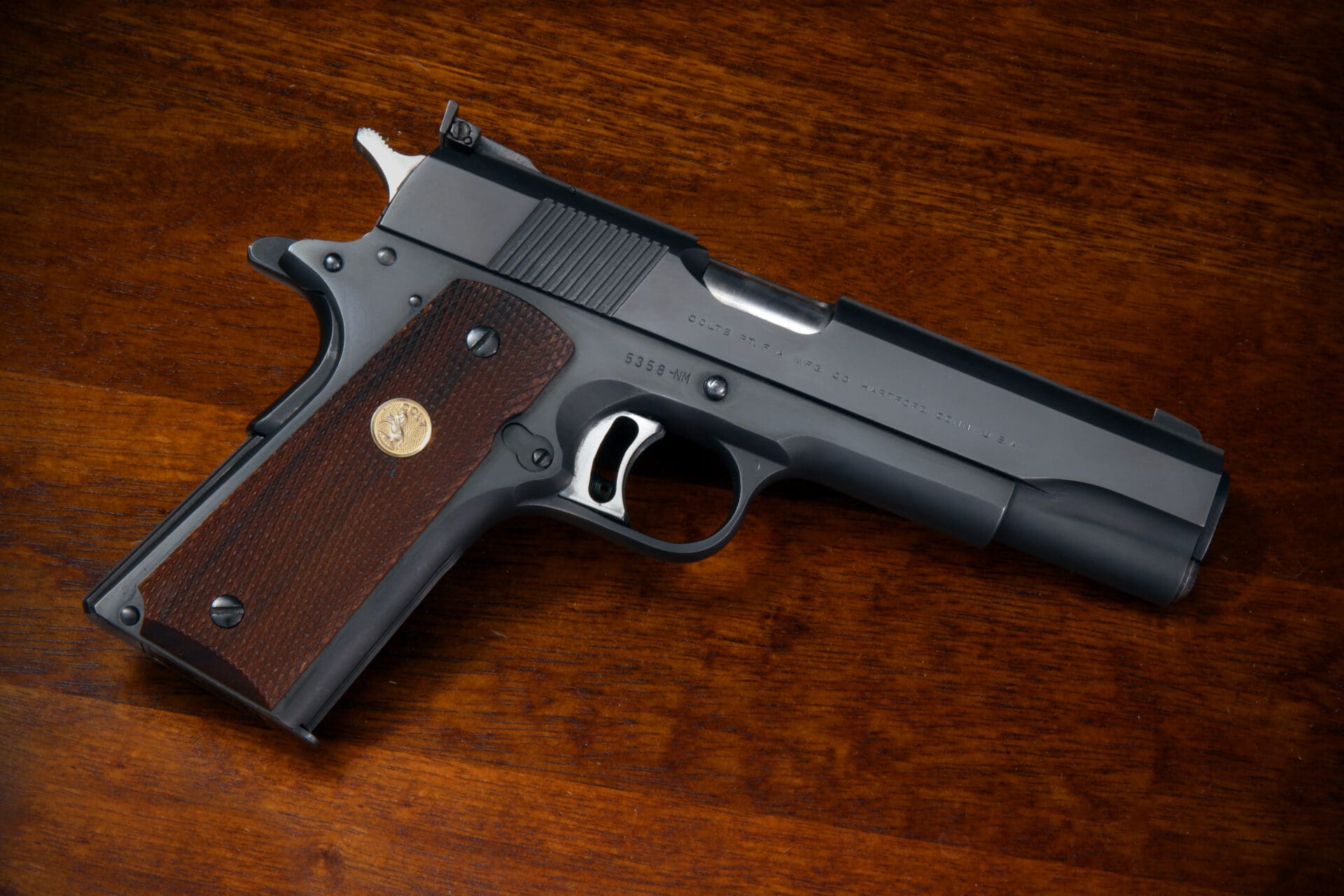
Buying your first 1911 pistol? Congratulations! It’s great when someone has actual taste in firearms.
Just kidding. Many pistols are great, and the classic 1911 platform – while it has its limitations – is a proven and effective pistol for almost any application, from sport to personal defense and all points in between.
John Moses Browning‘s meisterwerk is still wildly popular to this day for a lot of very good reasons. With its slim design, it carries incredibly well. It feels good in most shooters’ hands and the single action only trigger is typically among the best you’ll find in any handgun.
But what should you look for in your first 1911 pistol?
Well…that’s actually a complicated question.
The absolute basics?
It should fit well in your hand, and point naturally. You should be able to get a natural shooting grip, reach the trigger easily, and manipulate the slide and controls. And you should be able to see the sights on the model you buy. That’s about all you need in any gun, really. It should fit your hand and have a trigger you can use effectively.
All the other bits and features – what kind of sights, construction method, different types of safety levers, recoil spring systems, etc., would – and has! – filled entire books. We’ll go over that a little more, but this is about getting your first 1911 pistol.
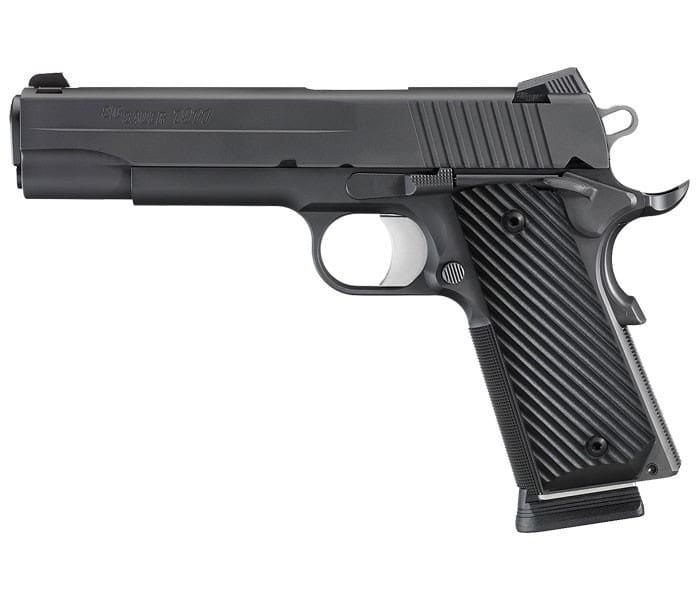
Outside of the basics, what you should look for in a 1911 pistol depends a lot on what you’re getting the gun for. If you understand that, then you can make a purchase that best suits you and your needs. That gets you into a gun that you’re going to like a lot more.
You can get a 1911 for literally any and every purpose; the platform is that diversified. There are some that will do basically everything. Target shooting, home defense, concealed carry, collecting, even handgun hunting. That much is your decision; you have to figure out what you want it for. So let’s go over some basic features and how they matter.
So let’s talk chambering. The classic 1911 chambering is .45 ACP, and the pistol will hold, with most magazines, 7+1 or 8+1 rounds. Another popular option is 9mm, and in truth it’s better in that the smaller round increases capacity to 9+1 or 10+1 (depending on magazine). It’s also cheaper and easier to shoot.
Other common chamberings include include .38 Super, 10mm, .40 S&W, and .22 TCM. If you’re interested in handgun hunting, 10mm or a pistol converted to .45 Super (basically .45 ACP +P+) are the better choices, but 9mm or .45 ACP is best for most purposes and shooters.
Next, let’s talk frame size. We will be discarding, for these purposes, the micro 1911s, i.e. the Colt Mustang and its various clones.
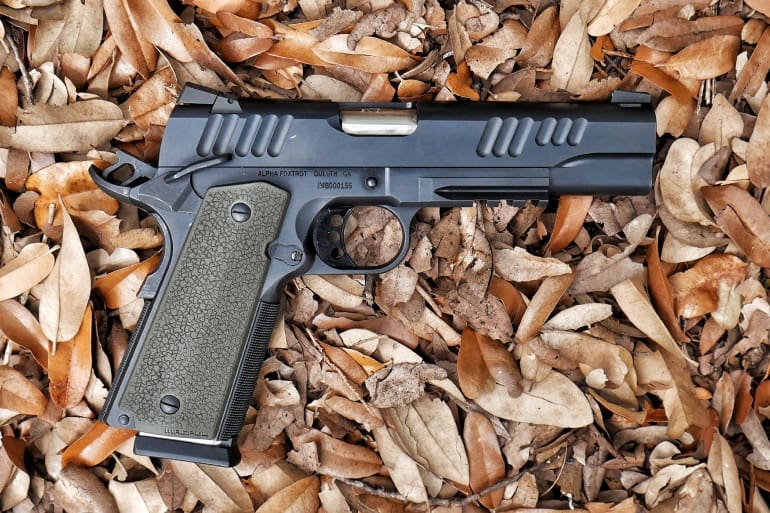
Most common is the Government frame 1911, which has a 5-inch barrel, a 5.5-inch tall grip, and is around 8.5 inches in total length.
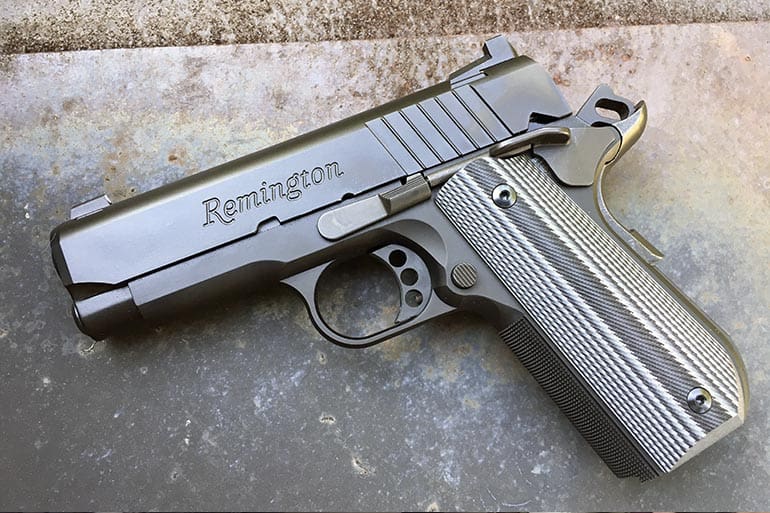
The Commander size frame (pictured above) cuts barrel length to 4.25 inches and overall length to around 7.75 inches, but otherwise remains the same.

The Officer size frame and CCO (Concealed Carry Officer) frames have a shortened grip, usually down to 5 inches. This costs you one round of capacity, so .45 ACP pistols will have a 6+1/7+1 capacity, and 9mm models will have a 8+1/9+1 capacity, depending on the magazine.
The Officer frame classically has a 3.5-inch barrel, and the CCO classically has a Commander slide and barrel on an Officer frame.
Keep in mind that Commander, Officer and CCO frames can vary in specifications between manufacturers. Some Commanders have a 4-inch barrel (such as Kimber) and some have a 4.33-inch barrel. Some Officer frames have as short as a 3-inch barrel.

The Government frame is renowned for target shooting, as it remains a popular competition pistol to this day. It CAN also be carried every day, and plenty of people actually do; it’s one of the more popular full-size pistols for concealed carry.
Officer and CCO pistols are the easiest for concealed carry, but are a little livelier to shoot. Commander and Lightweight Commander (alloy frame for lighter weight) pistols are a middle ground between the two.
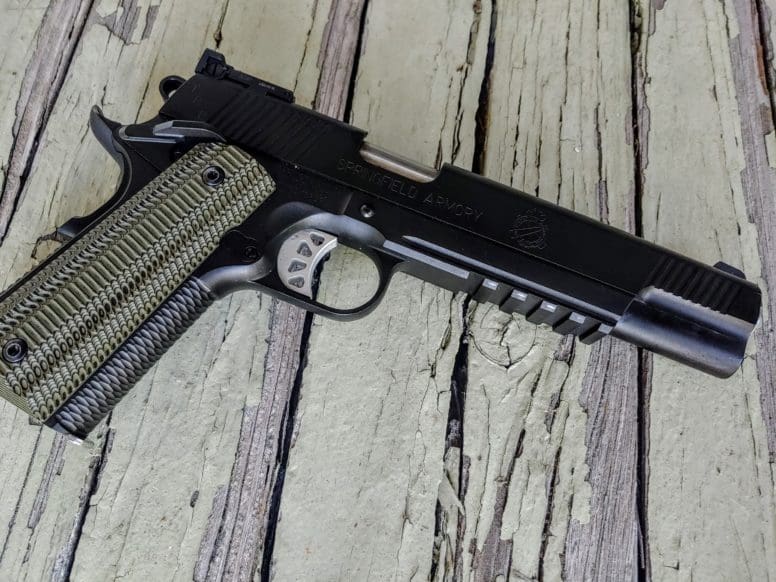
Another feature to be aware of is whether or not you want to use a laser/light with your pistol. Laser grips are certainly available, but a mounted light requires a railed pistol. However, if this is going to be a carry gun, look before you leap. Not all 1911 frame rails are the same, so make sure that you can get a holster for the pistol and light you’re considering.
Another feature you need to look at is the sights and sight cuts. Sights are the most commonly upgraded part of any handgun, and 1911 pistols are no exception.
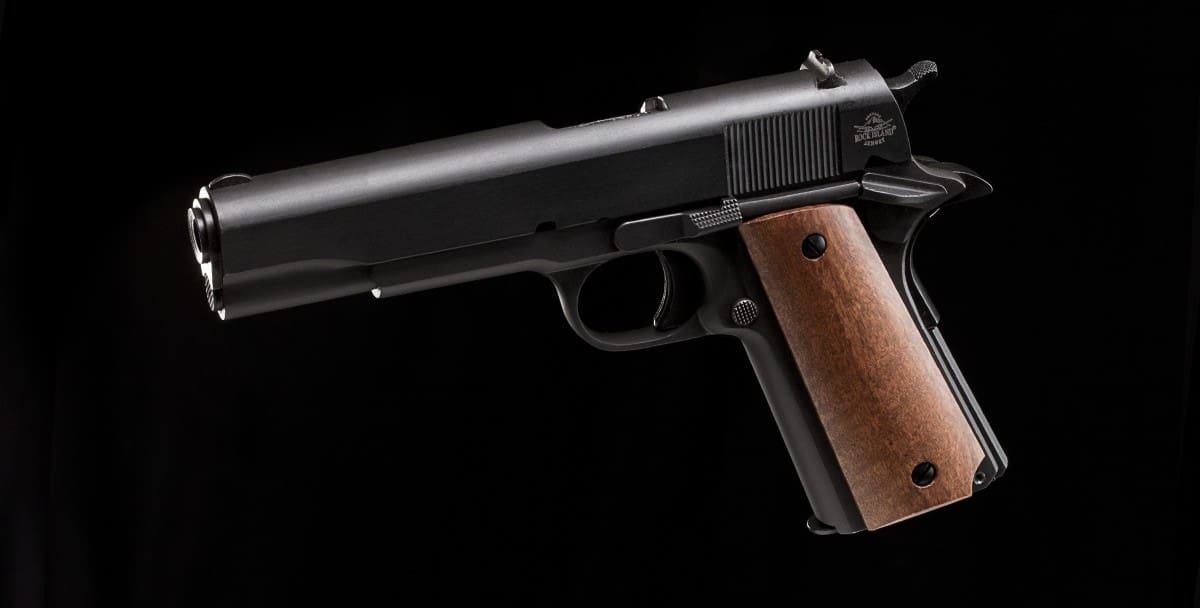
The available sights on factory pistols range from basic black steel sights (above), white dots, fiber optic and night sights. You should get a pistol with a sight set that fits your desired purpose. However, if upgrades are in your future, select a pistol with sight cuts that make this easy.

The classic sights are a pinned front sight and a dovetailed rear sight, often called the Government sight cut. Other pistols will have use Novak dovetail dimensions. Some, and it’s incredibly annoying when this is the case, will use a proprietary dovetail cut.

If upgrading your sights is likely, the classic Colt Government sight cut or Novak sight cut is what you want. This way, you can either leave the stock sights as is or upgrade them easily, without having to get the slide milled. These are, far and away, the most popular dovetail cuts among pistol makers AND aftermarket sight producers when it comes to 1911 pistols.
You might have heard of Series 70 and Series 80 trigger systems. Series 70 and Series 80 refers to pistol model lines made by Colt, used colloquially to refer to pistols without (70) and with (80) a firing pin block. This feature is to prevent the possibility of a discharge if the pistol is dropped; the firing pin is blocked unless the trigger is pulled.
Some insist a Series 70 pistol has a better, crisper trigger pull. This is a matter of some debate; my experience is that it comes down to who makes it. A good trigger is a good trigger, firing pin block or not; excellent and lackluster examples of both can be found. Your mileage may, of course, vary.
Now let’s talk about certain other optional extras. Another common upgraded feature is the grip safety, as many people will add a beavertail grip safety lever to their pistol.
This enables a higher, tighter shooting grip on the pistol and will also prevent hammer bite. They aren’t strictly-speaking 100 percent necessary, but they are darned nice to have.
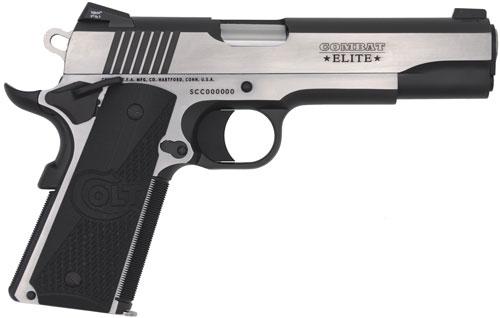
Ambidextrous safety levers are a plus, especially if you train to shoot with both hands. However, some people find them uncomfortable; you’ll have to figure that out for yourself.
Now let’s talk price. How much should you spend on your first 1911 pistol?
The truth is that you can spend not too much or you can spend A LOT, and you can also get a decent pistol at almost any price point.
Entry-level 1911 pistols can be purchased for as little as $300 for bare-bones imports. Most first-time buyers will spend up to $1,000. It depends a lot on who makes it and what adornments they want.
Guns with a bit more in terms of bells and whistles will demand a bit more. There are so many on the market that this post would be book-length if we got into it, so we’ll button this like so:
First, consider what you’re going to do with the gun, then figure out which features you want. After that, hunt down the different makes/models with the specs and features you’re looking for. Handle a few, and rent a few if you can and shoot them.
The 1911 is still popular today because the design shoots and carries so incredibly well. What you’re really looking for is a good fit in the hand, a gun that fits what you have in mind to do with it, sights you can see. All the rest…is really up to you.
So…what do you think? Any recommendations as far as first 1911 pistols go in terms of make and model? Sound off in the comments.




I bought a used TLE/LR II Kimber and that pistol is a nice pistol. I’m still not into the lure of the 1911 but I’m trying. I’ve shot some crap 1911’s and some really nice 1911’s but I’m not quite sold on the pistol yet. I guess that’s blasphemous but give me a S&W M&P 45 or a Glock 21 and I’m as happy as can be.
Snitch, personally I believe Hk makes some of the very best .45s. A used full size USP 45 can be had pretty cheaply compared to the retail price (retail is about $900). If you stumble on a police trade in they can often be had for around 500 bucks and with little wear other than the holster variety. Those USP 45s are a garbage disposal and will chew up, spit out and power through just about anything. I couldn’t recommend a pistol more for straight out of the box. Plus the controls are very 1911-ish. The only complaints I hear from some are about the gun being big (to be fair it is) and the double action trigger. There are a number of different ways to set up a USP, and it can be carried cocked and locked optionally in the v1 format. If it doesn’t fit your hand though…it doesn’t fit your hand. It’s one of the most proven pistols out there and worth owning for sure. If I had to pick just one handgun to grab for the apocalypse I would take my USP 45 over any others.
https://www.youtube.com/watch?v=-omukX5ScM0
I do like the HK USP. The 9 is a fantastic pistol and I have shot the 45. I also like the Walther PPQ 45. The Sig P220 is outstanding. I just am struggling to find the right 1911 I guess. The Kimber is great but is fussy on ammo. I don’t need a fussy pistol. I have friends who swear by the 1911 but at the end of the day, I’m grabbing something else.
I’m glad you like USPs too. I’ve personally owned a lot of 1911s… WIlsons, older Colts you name it. In my opinion, right now, it’s hard to go wrong with a Springfield Armory. My favorite 1911 in my collection is a Springfield Pro model that I had Nighthawk mod just a tiny bit and re-finish in Nitride. I’ve just about sold pretty much all my other 1911s because I like it that much. Maybe see if you can find a pre-owned TRP, they are quite frankly excellent for the money.
One with a SINGER roll mark, but then again, I prefer collectibility over ergos and that’s a topic for another article on the subject. 1945 and prior manufacture government issue is what I look for.
I hope I come across a “Rock-Ola” rollmark I can afford one day, the jukebox company cranked them out for the war effort. I had a job in the 80s maintaining jukeboxes for a local amusement company. It was a good thing, being able to play all the upright video games I wanted pretty much killed my interest in video games for the home.
It probably saved me a shit-ton of cash… 🙂
https://www.thetruthaboutguns.com/?s=singer+1911
“There are some that will do basically everything. …collecting, even handgun hunting.”
and that’s the one i want. it goes handgun hunting for my collection.
Expect that Singer to run you north of $50k. And for some, FAR north.
My first pistol was a Springfield Armory 1911 in basic A1 configuration. A very nice gun for the price. My only complaint is that the front sight has gone a little wobbly over time and needs to be re-staked. I like the classic 1911 look; usually not so keen on the amped-up competition versions, though I’ll admit to finding some of them pretty cool looking.
It’s a little unfair, by the way, how many “meisterworks” John Browning actually produced…
Dont buy one without a beaver tail! Only old farts have experienced that old timey fully cured medical condition known as “hammer bite.”
“Slide-bite” cut my hand more than once on that AMT backup .380 I once had…
I dunno, if I want a JMB 9mm I think I’m going for a Hi-Power. That said I’d carry one in .38 Super or even the lethargic .45 ACP.
For feeding, ramps are nice. When using a typical roto, then barrel to slide clearance should be minimized on open slide. It helps to keep the rounds from catching on the edge of the ramps. Be careful because sometimes too much of a good thing kills reliability when dirty.
Then barrel to slide clearance slide closed should be about .005″ish. I’ve seen these all over the place for a few reasons, but mostly the link length and sometimes the shroud to headspace length is too long.
1911’s are never sprung correctly, partially because .45 ammo has went through a huge variation of velocity. Browning’s original was 13.5lb, 16lb is semitypical now, but 18lb is realistic for most modern loads. In a 10mm, I have used a 26lb that runs flawlessly.
I guess what I’m eluding too is that there have been a plethora of parts produced and sometimes installed on factory built stuff. If the 2 clearances I mentioned are pretty good, then the rest is easy to make better. If a 1911 is build right it will shoot lights out. I shoot 100yd steel and the rifle guys come over to see what crazy concoction I’m up to, only to find out it’s a nearly stock 1911 A1.
Beavertails? Boy howdy!
“Beavertails? Boy howdy!”
*snicker* 😉
https://www.youtube.com/watch?v=wS3LWOTCW4A
Good One! :))
Things that are a no go on a 1911:
-Poor slide to frame fit
-External extractor (all sorts of problems with these, I’ve never seen it executed very well)
-Swartz safety (grip safety actuated firing pin block) * series 80 is a better concept, but can be miss-timed, stick to the 70 series system. Newer 1911s are running smaller lower mass firing pins, coupled with proper firing pin springs the drop safety issue, really isn’t one.
-MIM parts for essential components like sears, disconnectors etc.
– Trigger less than 4.5 # for a carry or duty gun
-Cheap magazines. (this is a huge one) Solid choices are; ACT mags, Metalform, Tripp, and the newer Wilson 8 round mags with the extended tube. (avoid the old 47d with the shortened spring and follower) The followers on the Wilson mags wear out faster than most because where they engage the slide stop is just plastic.
-Full length guide rods (with a *) I don’t feel these are needed on a business gun, but there are worse unnecessary mods for 1911s
Some additional notes:
If your 1911 is going to be used for carry or duty, I would stick to a full size 5″ Gov’t model in .45 auto. Always run the extractor test on a 1911 intended for carry. The process is simple (always chamber 1911s from the magazine, don’t snap the extractor over a cartridge rim by dropping a round directly into the chamber) Load several magazines for this. Chamber a round manually each time, remove the magazine before each shot and then fire. Rinse and repeat this drill for several magazines. The casings should not exhibit erratic or weak ejection. If they do, the extractor is probably not tensioned properly, I would not carry it before getting the extractor tuned. Always use grips that fit well and pin the plunger tube in place. I will often use a little dab of the purple Loctite on my grip screws. If the plunger tube comes loose it can lock the gun on safe. Always be checking your plunger tube to make sure it isn’t loose, make sure it is properly staked on. The slide stop on a 1911 is really just a slide stop, not a slide release. Recoil springs do regularly need to be refreshed. I change mine every couple thousand rounds of standard pressure ammo, adjust accordingly depending on your ammo type and purpose for your 1911. Other than that, always remember to properly lubricate your 1911. It needs a light coat of a high quality oil on the rails, a bit on the barrel link, and a few drops in the locking recess/barrel hood area. You don’t have to go crazy with the lube, but 1911s do not like to run dry, it will accelerate wear and cause malfunctions. I generally avoid heavy grease. Understand you get what you pay for and the 1911 is not an exception. Springfield Armory generally makes a solid 1911, particularly the Professional models or Custom Shop guns. Nighthawk is my personal favorite higher end semi-custom shop, they are my go to for 1911 work right now.
I used to say the same thing about the slide lock not being a slide release, but I’ve learned different since then. If the goal is to chamber a new round, use the slide lock/release. It’s faster and just as reliable as any other method, and often more so.
None of my carry 1911s ever have anything more than a 4lb trigger, and I like a 2.5lb a lot more. There’s no need for a heavy trigger.
JW, whatever works for you, but in my own experience on some 1911s, I have seen the notch on the slide that engages with the slide stop start to round off over time. Playing around and dropping the slide with the stop continually on an empty chamber is also a way to wreck a trigger job on some of these really fancy setups. A little food for thought on the technique; the slingshot method works with nearly any and all semi auto handguns, including those few without any external slide controls. It’s a gross motor skill and only a negative issue if you ride the slide while racking it. Using the stop as a release is faster in most cases yes, but personally, I am not worried about my split times or being super fast for a stopwatch I am not competition shooter.
JW, I would also add, that I obviously disagree with you on trigger weight. No duty or carry gun should have a super light trigger in my opinion, competition is another thing altogether. Right at 4.5# is where I like it on an all business 1911.
The slide release on my 1911s worked just fine. Just like the slide release on my Beretta 92.
Go figure…..
Itd a better boat anchor then a Glock . Al Duel purpose firearm
Yeah, but a Glock is better for a Possum, as dirty and nasty as their rat-infested burrows are.
Less rust… 😉
Conversion kit for 45 Super: 10mm recoil spring. You’re welcome! 😉
If it’s a 1911, depending on the manufacture and the stoutness of your .45 Super load, you’re going to need a bit more than that. Ruptured cases with a .45 Super are zero fun.
I like the basic guns from a controls standpoint. I’m not ambidextrous and I dont get but by the slide.
I dont mind the shorty sights on old 1911s but the taller ones are ok too ( and better for any long range shoting).
The main thing for me is feeding and ejecting. Some 1911s perk along just fine but many need fluffing and buffing and a little port work.
45 is the most pleasant to shoot but a Super 38 is fun if you have ear protection.
I shot one of the original Delta Elites a bit. Seemed like too much sugar for a dime. Too much wear and tear and mangled brass.
Maybe the newer ones are better but I will stick with revolvers for serious calibers.
Ive owned $300 1911’s and I do own $2200 1911’s and everything in between. There is no comparison to a $300 beat to fit and paint to match 1911 and a multi kilobuck hand made gun. They just feel, function and shoot better. Buy once and cry once. But if you buy a really good 1911 first time out or 20th time out, you will buy another one. There’s just something about them.
My first 1911 was a Colt Government Model, Series 70, made in 1970 (no, I’m not that old, I bought it used). I’ve had a couple others, but I’ve kept the Colt.
For me my first and still only 1911 qas bought on being a crazy good deal. It was a Black Friday sale at Sportsmans Warehouse maybe five years back. A co-worker mentioned it, a PARA USA EXPERT in stainless steel for $299. I figured at that price, though I am loathe to go shopping on any sort of a crowded day for anything, I just had to go for it. Got the last one in the store after railing at the management for allowing people to buy as many as they wanted, saw one guy with a shopping cart load of AR’s and PARA 1911’s, must have had ten of them in there.
They ran outas they called my number and I chewed out the manager (it wasn’t just me, lots of pissed off buyers, you took a number and watched people rolled mass quantities out of there) and was nearly out the door when they called me back in.
Somebody had failed their NICS 🙂
So, out comes the concealed weapon permit and my driver license and credit card and SOLD!
So price and MADE IN USA, that’s how I picked it. Shoots pretty good too, I like it a lot.
I grabbed my first (and only) 1911 around 18 months ago, a NIB Para Ord GI Expert 14.45. I ended up paying around double what you paid, but considered it a good purchase.
My first and only 1911 to date is a Remington R1 Enhanced. For $460 after rebate, it was a price I couldn’t refuse. I don’t have much 1911 experience, but I like it so far. I wanted something I wouldn’t feel compelled to upgrade immediately and that’s what I got. Nice trigger, good sights, and G10 type grips are all included.
Lets see, I don’t see “external extractor” or “2011” anywhere in this article, so it can be disregarded because any 1911 that doesn’t feature at least one of those is simply obsolete. If fact the article should be a demand to the industry for an affordable(under $1000) 2011 with a external extractor because it’s ridiculous that such a thing doesn’t exist.
1911 obsolete??? On which planet?
Shooting much are we?
Wouldn’t an “affordable / under $1000 2011” be a………..Glock?
CZ P 10 C…..14+1, outstanding trigger for the price / catagory, $450+/-…………there is your 2011 for half your longed for $1k.
The market has come to your rescue now go forth and buy something and support the industry
I’m really more of a revolver guy. But felt I needed a 1911 to go along with my scout rifle tribute to Col. Cooper. I found a great deal on a Ruger SR1911 LW commander type. I bought this first 1911 as part of my “buy a .45 in honor of President #45” endeavor. Thought it only fair, as I bought many .44s during President #44’s two terms.
JWT: This is off topic, but I just bought a LWRC “Other Firearm” AR-15 12″ barrel. With the velocity loss, what bullet weight range is best for defense purpose? 55, 68, 77?
I’ve read some use SBR’s for hog hunting inside of 100 yds. with 77 grain OTM loads, isn’t the lower velocity affecting the lethality on hogs?
The Series 70 vs. 80 trigger issue isn’t much of a debate among gunsmiths. You can’t get all the pivoting/sliding pieces in the Series 80 to have the same level of finish as the hammer/sear interface in the Series 70. As you pull the trigger on a S80, you feel the firing pin block being moved out of the way, and you feel the drag/creep of the plunger through the half-moon cut on the firing pin. The additional spring force to push the firing pin block out of the way also tends to make the S80 triggers feel “mushy” up to the point where you come up against the sear.
That said, the best solution I’ve seen is the nitrided S80 parts from outfits like Cylinder and Slide, which remove much of the friction and drag.
I was disappointed with the trigger and overall quality of my S 80 Colt Combat Commander. Sold it and purchased a Kimber Compact Stainless (S 1) which, after some minor tinkering, has proven a superior weapon.
More recently I acquired a Para Elite Commander, fully expecting to rework/replace the S 80 FCG. But I was pleasantly surprised- the trigger break was excellent as supplied, and improved even more after some light stoning.
Fit and finish are excellent, as are the two factory mags. Trigger shoe and MSH are plastic, and there are some MIM parts. I’m not convinced the FLGR is absolutely necessary.
Round count is about 1000. No signs of uneven wear and it has never failed to feed or function. So further work is on hold.
Quite pleased so far- I reckon this is the best $500 I ever spent on a 1911.
Already bought my first 1911. Bought an ATI FX45 Government from my brother-in-law for 300 bones. He bought it, put a mag or two through it, then sold it to me. I found out why shortly after I got it. With the ACT-Mag it came with, it FTF constantly. A couple of Kimpro Tacmags helped considerably, but if it got even slightly dirty from shooting, it would start FTF again. What solved that was taking a felt polishing wheel and some polishing compound to the feed ramps and chamber. No grinding at all, just polishing. Even the ACT-Mag will feed reliably now, and it doesn’t care if it’s dirty or not, it still feeds fine.
Bought my first handgun over 25 years ago, and have bought many more since. Never seriously considered a 1911 style pistol. Still don’t see the need. If I want a handgun in .45 ACP, there are many more modern designs for it, most of which have greater magazine capacity than a 1911.
Put another way, “”Cause my granddad carried one in WW2” isn’t enough to sway me.
First I’m not a gun divà. Read to mean ;my gun cost more than yours ;not me. I read a lot about guns, especially before buying. Bought what I thought was a RIA 1911a1 full size tactical. 45acp from my local ffl pawn, shop. It was ordered new, waited about 3 weeks. Finally came took it out of the store and home to open. When I did weren’t too happy. Turns out supposedly he got the catalog numbers wrong, so I ended up with an mid-sized tac 2. He offered to put it on his shelf and order the correct one, but another long delay so I swallowed the fu . Glad I did. It goes bang every trigger pull. With the cheapest ammo around mixed mag load outs just keeps banging. It got Novak night sights and 30 yards off hand rapid fire they all go into man size black silhouette head. Probably capable of better with a good shootist. I’m happy, oh , using one factory mag and three different makers all real cheap. I ain’t fancy. After over 300 rounds it hasn’t failed to puke lead yet. Price was $549 w/tax.
I have owned H&K’s (Tacticial, USP’s 45 &9’s), Glocks 17,19 & 21, Springfield XD & XDN & then the Sig world of coarse I am 60 years old but now just acquired a taste for a 1911.
I did not want to spend a fortune but I have always loved Colt so I had do some research and found this article boy it was a big plus.
I google a few around $500 – $700 range then started my journey into the unknown. The first 1911 that I looked was something basic, I wanted something to work on and upgrade so that if one day I could afford that Gold Cup.
I was really surprised with the Rock Island STD mil spec. The first thing I did was put G10 grips and then take one thing @ a time. The gun shoots fine after the first box realized sites need upgrading because @ 20 yards I’m all over the target and you can’t tell if it’s the weapon or ammo.
The thing I wanted was to just do some work on the slide, trigger and fab my own sites plus from reading and talking to other 1911 owners they really just love working on them. This gun was around $500 and really just wanted something to keep in my truck or if I get a motorcycle keep in the bags.
I have ran over 200 rounds through it, no hollow points but no problems.
I own a number of 1911’s Kimber, H&K, and they are fine. The two that I like to carry and trust my life and the lives of my loved ones is two Colt Gold Cup Trophy’s, one in .45 ACP and the other in 10mm. I’m ambidextrous and carry one under each shoulder along with two extra mags for each in a custom holster specially made for me. I’ve been shooting a1911 since I was six. The very first time I fired a Glock it stovepiped. Enough said.
Comments are closed.